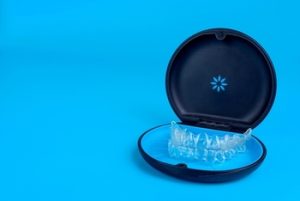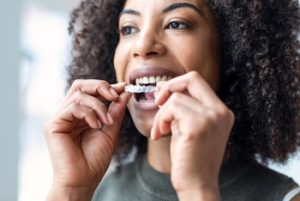For many people, a straighter, more confident smile is a dream. But the thought of traditional braces, with their metal wires and brackets, can be a turn-off. Invisalign offers a compelling alternative: clear, removable aligners that gradually shift your teeth into the desired position. But a common question pops up: does Invisalign hurt?
While Invisalign is generally considered more comfortable than traditional braces, pain can be possible.
Let’s delve deeper into what to expect regarding Invisalign pain and how to manage any minor discomfort you might experience.
Is Invisalign Painful? Brace Yourself For The Truth (Spoiler: It’s Not That Bad!)
Let’s face it: the thought of any dental work can trigger anxiety, and the question of pain often takes centre stage. So, is Invisalign painful? The answer, like many things in life, depends.
Compared to traditional braces with metal wires and brackets, Invisalign earns high marks for comfort. The clear, smooth plastic aligners are far gentler on the mouth and eliminate irritation to the cheeks and gums.
 However, it can involve pain and discomfort. When you start wearing a new aligner tray, you might experience temporary achiness or tightness in your teeth and gums.
However, it can involve pain and discomfort. When you start wearing a new aligner tray, you might experience temporary achiness or tightness in your teeth and gums.
This occurs because the aligners diligently work their magic, applying gentle yet firm pressure to nudge your teeth into their ideal positions. This pressure can translate to a feeling of tension or mild pain.
But here’s the silver lining: this discomfort is usually short-lived and on the milder side, typically lasting a few days until your teeth adjust to the new aligner.
By incorporating the tips and strategies we’ll explore throughout this guide, you can effectively manage any discomfort you experience and transform your Invisalign journey into a smooth path towards a smile you can’t wait to show off.
In addition to the temporary pressure, some people with sensitive teeth might experience increased sensitivity, particularly when consuming cold beverages or foods. However, this usually subsides within a short time.
If you have any pre-existing dental concerns or are particularly worried about pain, discuss them openly with your dentist. They can address your situation and provide personalised guidance to ensure a comfortable Invisalign experience.
Ouch No More! Fun And Easy Hacks For Invisalign Pain Relief
Let’s be real: no one enjoys feeling ouchies in their mouth. While Invisalign is known for being way friendlier than traditional braces with all those pokey wires, there can still be some temporary discomfort as your smile does its glow-up.
Here are some super easy hacks to keep things comfy and avoid Invisalign pain as much as you can:
Chill Out With A Cold Compress
Feeling a little pressure or tightness? Grab a cold compress (think fancy ice pack) and hold it against your cheek for 10 minutes on, 10 minutes off. The coolness helps numb the area and reduce swelling, so it’s like a mini-spa day for your smile!
Pro Tip: If you want to get extra fancy, wrap some crushed ice in a thin washcloth for a more comfortable application.
Pain Meds To The Rescue (Sometimes)
If you’re dealing with Invisalign jaw pain, over-the-counter pain relievers can be your temporary best friend.
Just remember to follow the directions on the label and check with your dentist or dental expert before taking anything new, especially if you have any health concerns. Medication is a short-term fix, so it’s always a good idea to chat with your dental crew for personalised advice on managing pain throughout your Invisalign journey.
Chewies: Your Tiny Teeth Gym Balls
Your dental expert might give you these cool little chewables called chewies. They help your clear aligners fit snugly around your teeth, minimising that initial discomfort. Think of them as tiny gym balls for your teeth!
They help spread the pressure evenly and encourage your teeth to move into their new positions without any fuss. Using your chewies as directed can significantly reduce discomfort, especially during the first few days with new aligners.
Dental Wax: The Magic Eraser For Pokes
If your aligners have sharp edges bugging your gums or cheeks, a small amount of dental wax can be your lifesaver. This handy stuff is like a magic eraser for aligner discomfort!
Just smooth it over any sharp spots, and Voilà—instant comfort. Remember, a little goes a long way with dental wax, so start with a small amount and add more if needed.
Soft Food Days For The Win
For the first few days after switching to new aligners, consider giving your teeth a little break with a soft food diet. Think yummy things like yoghurt, mashed potatoes, steamed veggies, and smoothies—anything that doesn’t require your teeth to do a major workout.
This helps minimise pressure as your teeth adjust to their new positions. Imagine it as a little rest and relaxation after a big move for your teeth! Sticking to softer foods for a short time allows them to settle in comfortably without any extra strain. As the discomfort subsides, you can gradually transition back to your regular diet.
Patience Is Your Superpower
Remember, any discomfort is usually temporary and fades within a few days as your teeth adjust to the new aligners. Patience is key throughout your Invisalign journey, my friend. Consistent aligner wear and these hacks will help you conquer any ouchies and smooth your smile journey. There might be a few bumps along the road, but a little patience goes a long way.
After all, the prize at the end is a straighter, healthier, picture-perfect smile that will have you beaming with confidence for years to come! Think of these minor discomforts as temporary milestones on your path to a dazzling smile.
Incorporating these hacks and maintaining a positive attitude can transform your Invisalign journey into a fun and rewarding experience.
From Ouch To Wow: How Your Dentist Can Eliminate Your Woes When Invisalign Hurts
While Invisalign aligner offers a comfortable alternative to traditional braces, there’s always a chance you might encounter some temporary discomfort during your treatment. Fortunately, your dentist isn’t just there to fix cavities; they’re your secret weapon for conquering any Invisalign woes that might arise. Here’s how your dental expert can transform your Invisalign journey from “ouch” to “wow.”
Personalised Comfort Plan
 Unlike a one-size-fits-all approach, your dentist can create a personalised comfort plan tailored to your unique needs and pain tolerance. They’ll consider your situation, including any pre-existing dental concerns, and recommend strategies to minimise discomfort throughout your treatment.
Unlike a one-size-fits-all approach, your dentist can create a personalised comfort plan tailored to your unique needs and pain tolerance. They’ll consider your situation, including any pre-existing dental concerns, and recommend strategies to minimise discomfort throughout your treatment.
For instance, if you have sensitive teeth, they might suggest using a desensitising toothpaste or opting for a slower aligner change schedule to allow your teeth more time to adjust.
Pain Management Magic
If you experience aches or pains, your dentist can advise on safe and effective pain management options. These might include recommending over-the-counter pain relievers or alternative methods like cold compresses or topical pain relief gels.
They can also inform you about the appropriate dosage and frequency of pain medication to ensure you’re managing discomfort effectively without exceeding recommended limits.
Alignment Adjustments
In some cases, minor adjustments to your aligners might be necessary to address specific areas causing discomfort. Your dentist has the expertise to assess your aligner fit and make any necessary tweaks to ensure optimal comfort and tooth movement.
Perhaps a specific aligner edge is putting excess pressure on a particular gum area. Your dentist can smooth out that edge or suggest using a small amount of dental wax for temporary relief.
Monitoring Progress And Addressing Concerns
Regular dental checkups are crucial during Invisalign treatment. Your dentist will monitor your progress, address any concerns you have about discomfort, and ensure everything is running smoothly.
They’re there to answer your questions, offer reassurance, and keep your smile journey on track. Beyond simply checking aligner fit, your dentist can also monitor your overall oral health and address any potential issues that might arise during treatment.
Advanced Techniques For Stubborn Discomfort
For some patients, there might be a need for more advanced techniques to address specific discomfort points. Your dentist might have additional tools or strategies at their disposal to tackle any stubborn discomfort and ensure a smooth treatment experience.
By partnering with your dentist and utilising their expertise, you can significantly reduce the likelihood of encountering significant discomfort during your Invisalign journey.
Remember, open communication is key! The more you share your experiences and concerns, the better your dentist can tailor their approach to ensure your comfort and a successful Invisalign experience.
So don’t hesitate to ask questions and leverage their knowledge to transform your smile journey from a potential source of “ouch” moments to a resounding “wow!” with a straighter, healthier smile you can’t wait to show off.
Frequently Asked Questions (FAQs)
Can I still eat my favourite foods with Invisalign?
While you can eventually enjoy most foods with Invisalign, it’s recommended to stick to softer options for the first few days after switching to new aligners. This allows your teeth to adjust comfortably to the new pressure. Hard or crunchy foods can strain your teeth excessively and cause discomfort. Once your teeth adjust, you can gradually reintroduce harder foods, but it’s always best to remove your aligners before eating.
How long does Invisalign pain typically last?
The good news is that any discomfort you experience with Invisalign is usually temporary. The most noticeable pressure or tightness typically occurs during the first few days of wearing a new aligner tray as your teeth begin to adjust to their new positions. This discomfort often subsides within a few days and becomes less noticeable with each new aligner set.
What if I experience pain in just one tooth with Invisalign?
While uncommon, you might experience pain in just one tooth with Invisalign. This could indicate that a particular tooth is moving more quickly than others to reach its desired position. There’s no need to worry if the pain is mild and temporary. However, if the pain is severe or persists for more than a few days, consult your dentist to ensure everything is progressing as planned.
I have sensitive teeth. Will Invisalign make them more sensitive?
If you already have sensitive teeth, Invisalign might be slightly more uncomfortable, especially when consuming cold drinks or foods. However, there are ways to manage this sensitivity. Using a desensitising toothpaste can help, and opting for lukewarm or cold water instead of icy beverages can also minimise discomfort. Discuss your concerns with your dentist; they might recommend additional strategies to address your specific needs.
What happens if I lose or damage an aligner tray?
There is no need to panic. While losing or damaging Invisalign trays is not ideal, it can happen. The best course of action is to contact your dentist immediately. They might advise skipping to the next aligner tray if it’s close to your scheduled change date. In some cases, they might need to create a replacement aligner.
Is Invisalign worth the potential discomfort?
 For many people, the benefits of Invisalign far outweigh any temporary discomfort. Invisalign offers a clear, removable alternative to traditional braces, making it a more discreet and comfortable option for achieving a straighter smile. By following the tips and strategies outlined in this guide, you can minimise discomfort and ensure a smooth Invisalign journey. The reward of a beautiful, confident smile is definitely worth it!
For many people, the benefits of Invisalign far outweigh any temporary discomfort. Invisalign offers a clear, removable alternative to traditional braces, making it a more discreet and comfortable option for achieving a straighter smile. By following the tips and strategies outlined in this guide, you can minimise discomfort and ensure a smooth Invisalign journey. The reward of a beautiful, confident smile is definitely worth it!
Invisalign Comfort: The Final Verdict On Your Smile Journey
Invisalign aligners offer a comfortable and discreet alternative to traditional braces, with minimal discomfort during the adjustment period. While some mild discomfort may be experienced initially, there are various strategies for pain relief and prevention.
By following these tips and consulting a dental expert as needed, you can navigate your Invisalign treatment with ease and confidence, achieving the smile you’ve always wanted.
Contact Woonona Dentists, Woonona, NSW 2517, at (02) 4284 4486 to navigate your Invisalign journey and flash a brilliant smile!
Sources
Charalampakis, Orfeas, et al. “Accuracy of Clear Aligners: A Retrospective Study of Patients Who Needed Refinement.” American Journal of Orthodontics and Dentofacial Orthopedics, vol. 154, no. 1, July 2018, pp. 47–54. https://doi.org/10.1016/j.ajodo.2017.11.028.
Fujiyama, Koji, et al. “Analysis of Pain Level in Cases Treated With Invisalign Aligner: Comparison With Fixed Edgewise Appliance Therapy.” Progress in Orthodontics, vol. 15, no. 1, Nov. 2014, https://doi.org/10.1186/s40510-014-0064-7.
Houlis, AnnaMarie. “How to Use Dental Wax for Braces (3 Best Products).” NewMouth, 12 Feb. 2024, www.newmouth.com/orthodontics/treatment/braces/dental-wax.
How to Relieve Pain From Braces in Teeth and Gums | OrajelTM. www.orajel.com/en/resource-center/toothache-pain-relief/how-to-relieve-braces-pain.
Initial Discomfort and Pain Perception Related With Orthodontic Aligners and Fixed Appliances: A Systematic Review – ProQuest. www.proquest.com/openview/53bbb0b799f3765e9cd42e25eefb96bf/1?pq-origsite=gscholar&cbl=2026366&diss=y.



